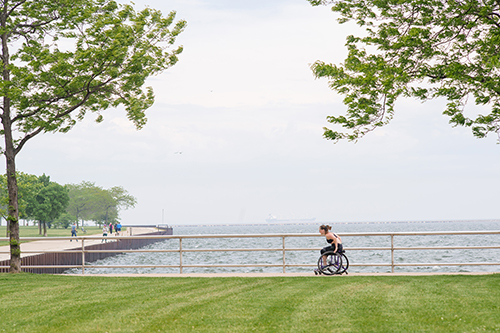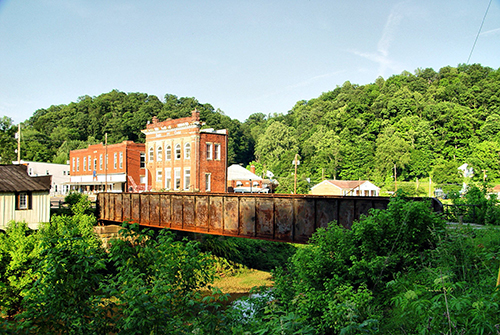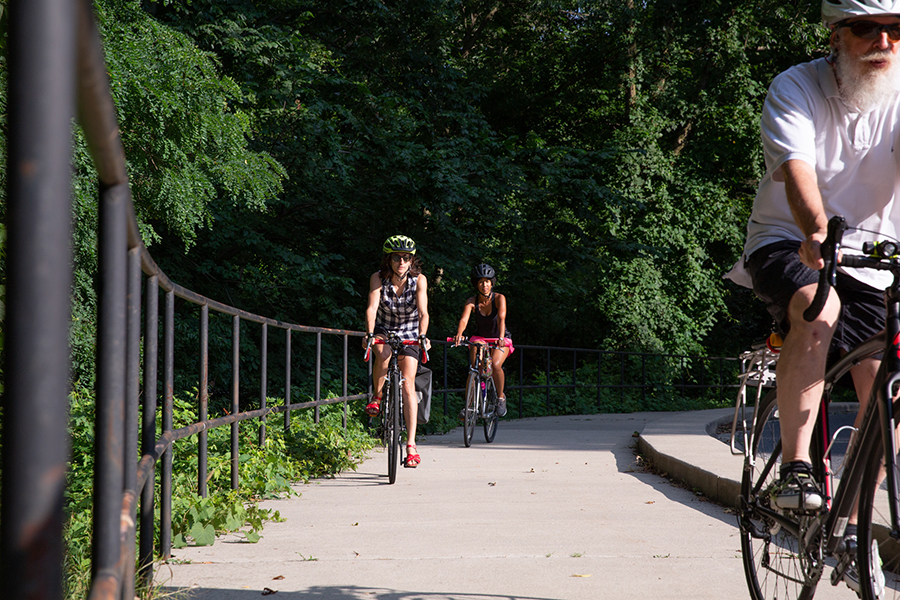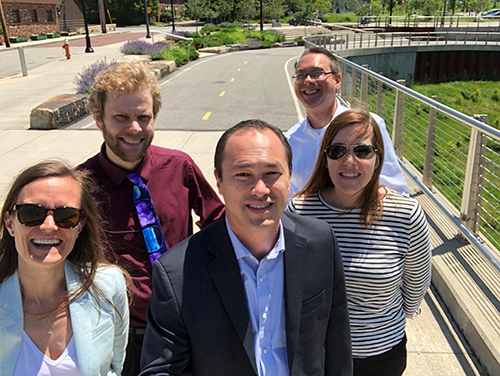A Q&A With Ryan Chao: Connecting Communities from Coast to Coast

For more than three decades, Rails-to-Trails Conservancy (RTC) has served as the nation’s preeminent voice for trails—setting the precedent that rail-trails are vital community assets, and establishing policies and practices that have helped result in more than 2,000+ completed rail-trails on the ground in American communities. Today, RTC is forging ahead with a focus on connecting this critical walking and bicycling infrastructure and demonstrating the powerful benefits trails deliver—spurring economic development, increasing mobility, protecting the environment, and creating social equity and balanced transportation systems that serve people of every age, socioeconomic background and ability.

RTC’s strategy to bring this vision to life centers on three kinds of change—changes in infrastructure, changes in policy and changes in behavior, making trail use key to our day-to-day lives. Examples of how this comprehensive strategy is applied can be seen RTC’s TrailNation™ initiative, with eight diverse projects ranging from 35 to a massive 2,700 miles, and the Great American Rail-Trail™, which will one day span 3,700+ miles between Washington, D.C., and Washington State. Recently, I had the pleasure of chatting with President Ryan Chao on how RTC is making this work happen in collaboration with thousands of partners and trail advocates across the country.
Q: Through its TrailNation portfolio and the Great American Rail-Trail—RTC has committed to help lead the quest for countrywide connectivity. Why is this critical for America?
I’m not exaggerating when I say that trails can transform America—in many places, they already have. Trails offer solutions to many of the issues we’re all concerned about, like health and wellness, economic development, sustainability, transportation justice and social equity. For example, RTC’s own economic impact studies show that trails already deliver more than $34 billion to the U.S. economy—a figure that could be quadrupled with enhanced trail connectivity and the shifting of short trips from driving to walking or biking.
When you look at the root cause of so many of the challenges faced by America, you find yourself examining how our cities and towns were designed—with priority given to a car-centric mode of transportation. Most people and communities lack the infrastructure—like trails, protected bike lanes and sidewalks—to safely walk and bike where they want to go. Yet, more than half of all trips taken in the United States are within a 20-minute bike ride or less, and more than one in four trips are within a 20-minute walk or less.
If we can move more of these short trips to walking and biking, we can generate an outsized impact on the physical, financial and environmental health of our people and our country. Trails are vital to making that mode shift happen.

Q: Tell us about a project in the TrailNation footprint that is expected to have a major impact on connectivity in their local regions.
A great example of the power and potential of connectivity is the Industrial Heartland Trails Coalition (IHTC), a 1,500-miles-plus multiuse trail network encompassing 51 counties in Pennsylvania, West Virginia, Ohio and New York. It will be a vast system of networks and spines connecting major urban centers like Cleveland and Pittsburgh, and rural communities in the Appalachian foothills and Ohio farmlands.

One really exciting initiative in the project footprint, which RTC is leading with partners in West Virginia, is an effort to connect Parkersburg to Pittsburgh via rail-trail. Only 22 miles remain to be built in the 150-mile West Virginia portion of this trail. And while this is exciting, what’s really powerful is the economic potential that the corridor could deliver. Connecting these existing rail-trails with the renowned Great Allegheny Passage (gaptrail.org) in southwest Pennsylvania would open the door to a recreation and tourism economy generating tens of millions of dollars annually, with the potential of attracting some of the 800,000 hikers and bikers that visit the Great Allegheny Passage each year.
This IHTC project has incredible potential to significantly enhance outdoor tourism, creating a new revenue stream for these communities—translating some of the “trail town economic development” that’s really grown alongside trails in West Virginia and Pennsylvania into a broader, regional impact. At the same time, this far-reaching trail network can also extend the rural-to-suburban-to-urban connectivity model that’s taking hold in Ohio.
We truly expect the IHTC to connect all people and communities in the system to new, equitable opportunities for economic investment, outdoor tourism and healthy lifestyles.
Q: Time and again, economic growth/tourism have been shown to be major benefits trail networks deliver communities. What’s a great example?
As I mentioned earlier, there is perhaps no more classic example of the catalytic effect of trails on economic development and tourism than the iconic Great Allegheny Passage (gaptrail.org). The Great Allegheny Passage is an international destination that has drawn millions to the natural beauty of western Pennsylvania.

The towns along the route, affectionately known as trail towns, have experienced significant investment as a result. From 2007 to 2015, these towns saw a net gain of 65 new businesses, creating more than 270 jobs. An estimated 40% of all business sales were directly attributed to trail visitors. The Great Allegheny Passage has not only helped bring millions of dollars to local economies but created a unified identity and pride in the region.
While the story of the Great Allegheny Passage is well known, we see similar outcomes repeated time and again in all types of places—rural, suburban and urban. Across the country, we see that the average local annual trail user spending is between $5 million and $7 million, which is more than $10 billion nationally. That’s revenue in communities that trails are responsible for delivering—and that’s powerful.
Q: Social equity is a central theme driving RTC’s trail network initiatives. Where can we see the effects of this right now, and why it is important?
We’re so excited to be part of a coalition leading the development of the Baltimore Greenway Trails Network, a planned 35-mile loop that will connect dozens of the city’s neighborhoods to each other and the downtown core. Baltimore is a great city, but many of its neighborhoods have been economically segregated and isolated from transit, outdoor space and each other for decades.
The vision for the trail network that’s planned in Baltimore has the potential to take down those barriers and create new connections to the places and activities that people living in neighborhoods throughout the city are seeking. When we talk with our neighborhood partners, we hear common themes about what they want—safe places for their kids to walk and play, better walking and biking access to jobs and schools, and more opportunities to be outside. The trail system can deliver those things in a way that is not only equitable but just—and led from within the community. Grassroots support for the project is growing in neighborhoods across the city, and many residents have already taken up micromobility and e-scooters as alternative forms of transportation. The greenway has the literal and symbolic potential to reconnect Baltimore.

Q: What have you found particularly inspiring as you’ve been touring the many developing trail networks across the country?
I’m a very lucky person. I have the honor of meeting inspiring people all across the country who are working to connect their communities by trail. And I have the privilege to write about and share many of their stories.

I’ll have plenty more stories to share in the future, but what comes first to mind is an inspiring two days spent recently at RTC’s annual staff retreat. I’m truly lucky to be part of a team that works each day to bring joy and opportunity to communities across the country. We spent our retreat together challenging ourselves on how RTC and trails can have the greatest impact for the most people. One thing I love about the trails and active-transportation community is that people come to the work with so many different experiences.
Just on our staff alone, we can count former bicycle messengers, elected officials, wilderness guides and environmental activists among our ranks. We, as a team, come from many different backgrounds, but we share a common goal of stewarding our mission and being of service to others.
Q: The Great American Rail-Trail will one day create a cross-country off-road connection. What do you foresee/hope the impact of this project will be when complete, decades from now?
The Great American Rail-Trail is our most ambitious project, and one of the grandest trail efforts ever to be launched. While it will indeed take many years to fully complete the 3,700-miles-plus route, we don’t have to wait until then to see its impact. Just since we formally launched the project in May, we’re already seeing new policy solutions being introduced by states that will deliver public funding for the Great American and other trails along the route, and we’ve celebrated several ribbon cuttings in the project footprint! Montana and Ohio both celebrated their first new Great American trail miles this fall.
At the same time, our country has perhaps never been more ready for the benefits that trails provide. We’re seeing an elevation in the national consciousness for what trails like the Great American Rail-Trail can do for people and communities, and we’re hearing from people across the country about what the Great American and trails mean to them individually. And while some care most about health and wellness, and others care most about accessing and preserving the outdoors, they all share a desire for connections. The Great American Rail-Trail will be both an iconic gift to this country and a symbol that, together, we truly can connect this country by trail.

Q: Favorite trail experience so far—and where?
I have the privilege of taking part in many inspiring trail experiences across the country. It’s impossible to name a favorite, so I’ll just name my most recent. I just got a new bike, and though the temperatures were chilly, I got out on the C&O Canal Towpath this weekend to take it for a spin. I only rode 30 miles, but in that time, I saw everything trails can do—from riding through historic trail towns revitalized by the towpath, to having conversations with people I’d never met, to seeing up close the change of the seasons with birds migrating and leaves falling. The beer after, while warming up by the fire, wasn’t bad either!

Donate
Everyone deserves access to safe ways to walk, bike, and be active outdoors.

